Site menu:
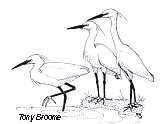
January 2017 Newsletter
Egrets Galore!.
Colour Ring Report.
December Bird News.
Forthcoming Events.
Latest Newsletter.
Egrets Galore!
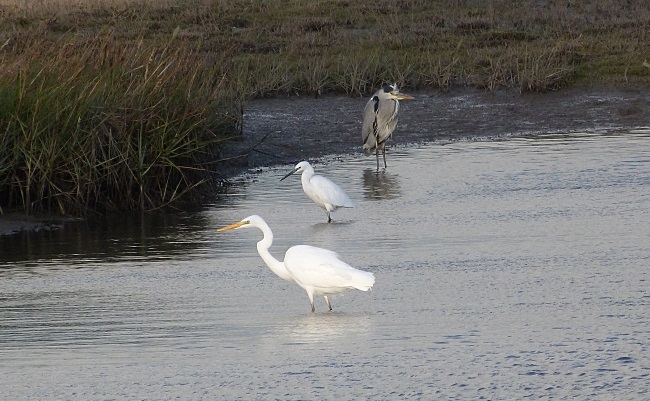
The three types of Egrets described in this article are incredibly
successful species having all greatly expanded their range in recent
years. This wasn't always the case and both Little Egrets and Great
White Egrets around 100 years ago were seriously in danger of going
extinct in Europe as they were being shot wholesale for their
plumage, whilst Cattle Egrets were largely confined to tropical Africa
and Asia. Times have certainly changed. The spread into North-west
Europe, including the UK, over the past 30 years or so seems to be
driven by a change in post-breeding dispersal with many birds heading
north-west to the mild maritime weather of the coast, rather than
heading south. No doubt the reasons for this change is complex but at
least one cause is very likely to be the long run of mainly mild
winters.
What was remarkable about 2016 here on the Dee estuary is that within a period of just three months we had record numbers of both Cattle Egrets and Great White Egrets to go along with the large numbers of Little Egrets already present, and also record numbers of the closely related Spoonbill - with the highest count of 12 in August and September, double the previous record. What caused all this is unclear but we did have several weeks of mainly easterly and southerly winds, and the RSPB have provided some superb habitat at Burton Mere Wetlands and the Dee estuary marshes which is obviously very much to the liking of these birds.
Cattle Egrets
The first Cattle Egret ever seen on the
Dee estuary
was at Caldy on April 30th 1997, we had to wait over 10 years for the
second when one turned up in a field at Neston in December 2007. This
bird was part of a national influx and it remained in the Dee Estuary
area
into February 2008. There was a gap of six years before
the next one which was a long staying bird at Burton Mere Wetlands -
from September to December 2014. There were none in 2015, so with just
three birds in 19 years we had no reason to expect anything unusual in
2016.

Nationally, as already mentioned, there was a large influx of Cattle Egrets in 2007/08 and BBRC estimated a total of 189 birds in the UK in 2008. A truly remarkable number when you consider that the annual totals for the whole of the UK for 2002, 2003 and 2004 were just two for each year, not untypical prior to 2005. After 2008 numbers dwindled and British Birds said there were just 10 new arrivals in 2013 and 28 in 2014. I don't have total numbers for 2015 but looking at BirdGuides during September and October that year most counts were of just one or two birds. 2016 was similar and in the first half of September there were just three different birds being reported up until the 13th when a fourth turned up at Burton Mere Wetlands, the first Dee Estuary record of the year; this bird stayed into October. Again looking at BirdGuides there is just a hint of a national influx in early October with four on the Scilly Islands in the first week or so, then three turn up at Marshside (Southport) on the 7th with the only other count greater than two being four on the Nene Washes on the same date. Here, at Burton Mere Wetlands, the single bird was joined by a second on October 15th then WOW five turn up on the 18th. These were present every day until November 10th when yet another joined them and there were SIX! These six stayed for over a week before some dispersed on to Burton Marsh and the last record of the year was of two there on November 28th. Through November and December the national records make it obvious that there had been a large influx across the country including five at Marshside (Southport) at the same time as our birds here. Like 2008 many birds concentrated in the south-west and counts include 11 at a site in Cornwall and seven in Devon, Ireland saw seven in both Cork and Wexford.
Whether
these influxes herald the start of a major colonisation of this species
into the UK along the lines of Little Egrets, remains to be seen. They
do prefer warmer and drier conditions than Little Egrets so the answer
is probably no, but it does seem likely that they will become regular
visitors to the Dee estuary and the southern half of the UK.
Great White Egrets
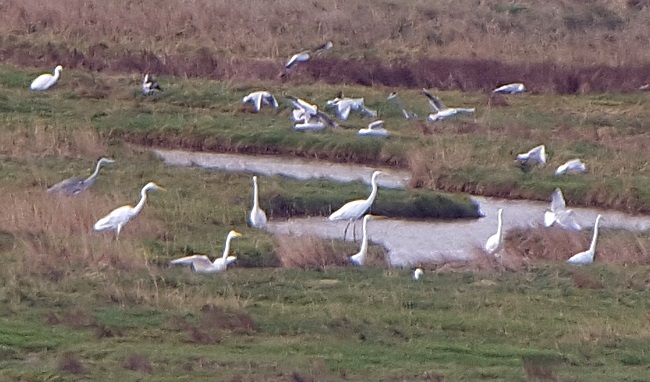
In my October 2015 Newsletter I said "My guess
is that it won't be too long before there
is a count of 10 Great White Egrets for the whole estuary" - it's nice
to be proved right! That month there had been five at Parkgate, a year
later we had six on October 7th but then couldn't believe our eyes when
first there were
eleven on Burton Marsh which had increased to twelve by
November 2nd.
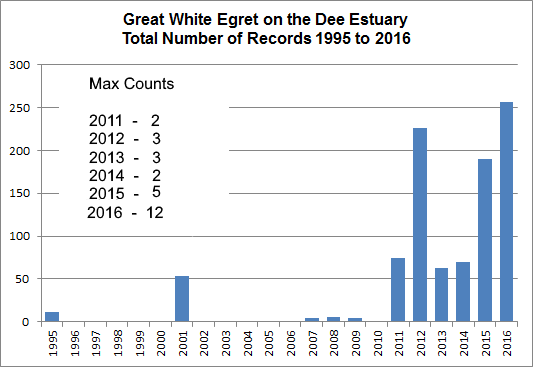
It was 1995 when we had our first Great White Egret here on the Dee Estuary but it is only since 2011 that they have become regular. Nationally, most birds are found in the south-east of England but the whole country has seen a steep rise in numbers since the year 2000, in 2014 there was an estimated total of 300 birds through the year, including right up to northern Scotland. Looking at BirdGuides records since 2014 it's obvious that even more birds have been in the country during 2015 and 2016, but nevertheless very few sites have had flocks in double-figures and the Dee estuary seems particularly attractive to them.
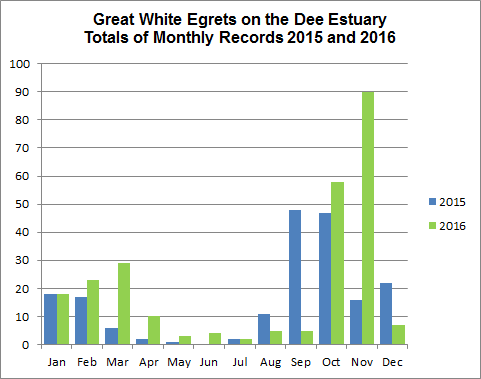
Explanation
of Bar Charts: 'Max Counts' are hopefully self explanatory but 'Total
Number of Records' and 'Totals of Monthly Records' might not be. These
Total Records are simply the sum of all the daily records - so if one
bird stays 10 days that is 10 records, if two birds stay 10 days that
is 20 records and so on. In 2012 the highest max count was only three,
but one or two of them stayed for a long time and hence there were a
large number of records, in contrast the large flock in 2016 only
stayed a short while so the total records for 2016 are only slightly
bigger than for 2012.
Little Egrets
The last time I wrote an article on Little Egrets on the Dee Estuary was 2004 when numbers had just started to rocket to, what we thought then, a remarkable 34 (see Species Spotlight - Little Egret). The graph below shows numbers continued to increase at a very steady rate until the harsh winters of 2009/10 and 2010/11. Since then they peaked in 2014 with 400, I'm not sure why there was a drop in 2015 - possibly numbers are beginning to stabilise or some birds were using alternative roost sites which weren't counted. Birds have been breeding on the Dee estuary for a number of years at Marsh Covert in RSPB Burton Mere Wetlands and pairs number around 50 to 70.
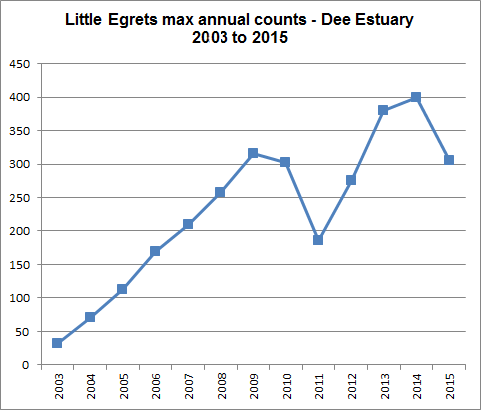
The picture nationally is interesting. The first record of breeding in the UK wasn't until 1996, they then rapidly colonised the southern half of England and Wales up to 2005, but then numbers plateaued out and, as in the Dee Estuary, decreased in 2010 and 2011. But since then numbers have increased even more rapidly and it seems this increase is being fuelled mainly by the colonisation of northern England and Northern Ireland. The Dee Estuary is the second most important site in the country for this species with a five year average of 280, equal to the Thames Estuary and second only to the Wash with a five year average of 495.
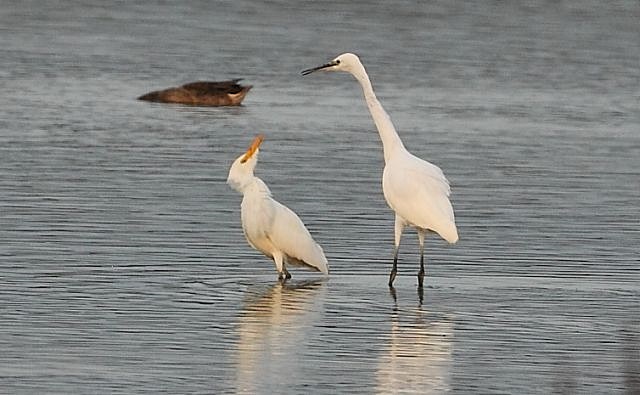
© Andrew Ingham
References and Sources of Information:
1. White & Kehoe, Report on scarce migrant birds in Britain in 2008-10, British Birds 107: March 2014.
2. White & Kehoe, Report on scarce migrant birds in Britain in 2014, British Birds 109: December 2016.
3. Cheshire and Wirral Bird Reports 1995 to 2014, CAWOS (and 2015 Bird Report in preparation).
4. Chas Holt, The changing status of the Great White Egret in Britain, British Birds 106: May 2013: 246-257.
5. Steve Barber, Great White Egret in
Cheshire and Wirral: Status, Bird News 90, November 2012, CAWOS.
6. Leigh Lock and Kevin Cook, The Little Egret in Britain: a successful
colonist, British Birds
1998 91:7.
7. BTO Wetland Bird Survey, on-line data: https://www.bto.org/volunteer-surveys/webs
8. Records from www.deeestuary.co.uk, and the many birders who contribute to them.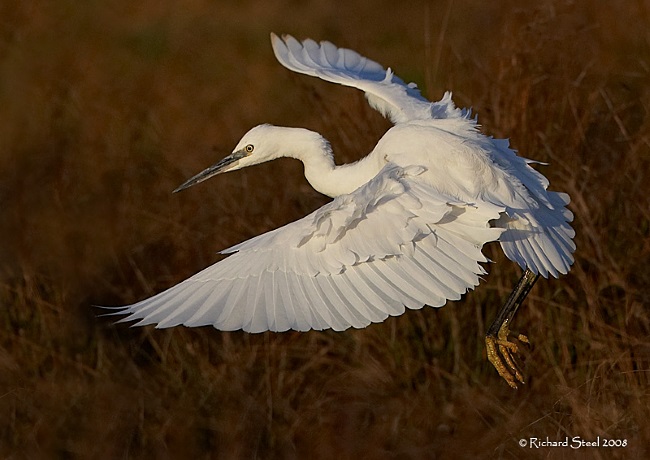
Colour Ring Report
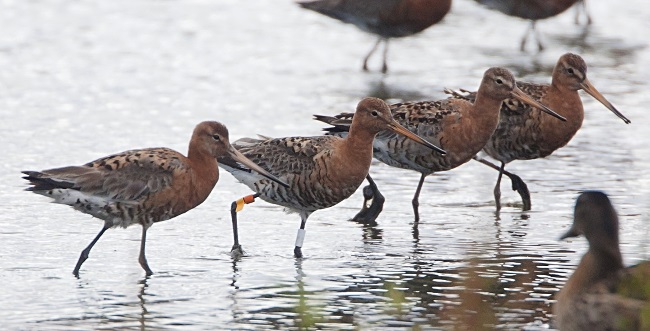
early August until the end of the year, ringed as a chick in Iceland in July 2012 © Matt Thomas
Black-tailed Godwits
At the end of 2016 I
thought I'd summarise the year's records. Black-tailed Godwits
have always formed the bulk of our colour-ringed records and there were
certainly plenty this year.
The year started quite badly with virtually no birds at
Thurstaston (they had all left to fly to the east of the country during
the gales and rain in November 2015) and the spring migration
was poor. However, post-breeding numbers rapidly built up at
the Gilroy Scrape where they moulted from breeding to winter plumage,
the first ones arrived mid-July and they stayed until the end
of
October,
and since then there have been very good numbers off Thurstaston
over-wintering.
The numbers at both Gilroy and Thurstaston have been surprisingly
constant at around the 2,000 to 3,000 level. Are these the same birds
at both sites? The answer is yes
and no!
The information gleaned from recording the colour ringed birds tells us
a lot about their movements. We found that about half the birds
moulting at Gilroy through the summer and autumn were regular
Dee estuary birds and were recorded subsequently at Thurstaston this
winter, as well as in previous years. The other half consists of birds
which winter further south including southern England, France, Portugal
and Spain, and it is very noticeable that these rarely stay for more
than a few days before moving on. By the end of October the birds tend
to stay almost exclusively on the estuary and it was very obvious this
year that our regulars were joined by a large influx from the east
coast of England, particularly the Wash. Analysis of the colour ringed
birds suggest that this influx consisted of half the flock, in effect
the birds which had moved south were replaced by
different birds flying in from the east.
There was also a hint from records for previous years
that some of these Wash birds were probably on the way to
southern Ireland.
You may wonder why some birds stay in this country whilst some move
south? There is a fascinating blog article about this very subject
written by Graham Appleton - see "Overtaking on Migration".
Here are some more facts and figures:
Observers: 12
people sent colour-ring records to me but by far the most records came
from Steve Hinde (mostly from Thurstaston) and myself (mostly from
Gilroy). Steve and I spent a large number of man-hours watching the
'Blackwits', it must be getting on for a total of 250 to 300 hours for
the year!
Birds and Records:
40 different colour-ringed Black-tailed Godwits were logged through the
year, not a huge number but these were recorded 500 times, an
impressive total.
Where were these birds
ringed?: 62% in Iceland, 13% on the Wash, 10% on the east
coast of Scotland, 5% in Ireland, 5% on the south coast of England, 5%
in France.
Richard Smith
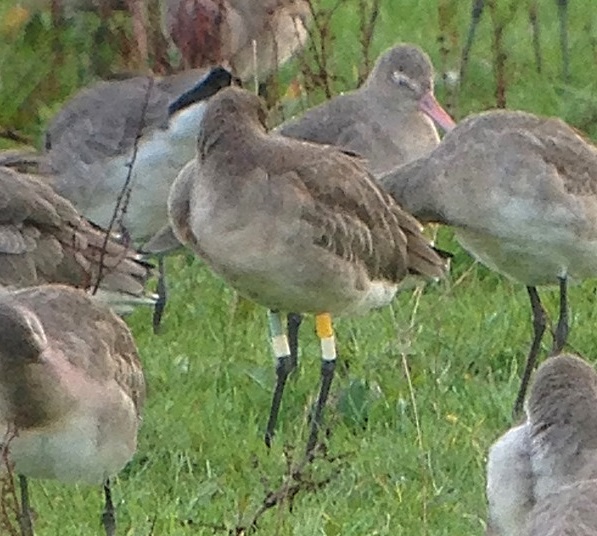
Top of Page
December Bird News
Waxwings is a species we all want to see, there were a handful of small flocks passing through our area but unfortunately just seen by a lucky few as none stayed very long.
There
are record number of over-wintering Marsh Harriers on the marshes and
they appear to be roosting overnight in the reed beds. Just how many
birds are involved is difficult to say but some are claiming it's in
double figures but certainly at least six.
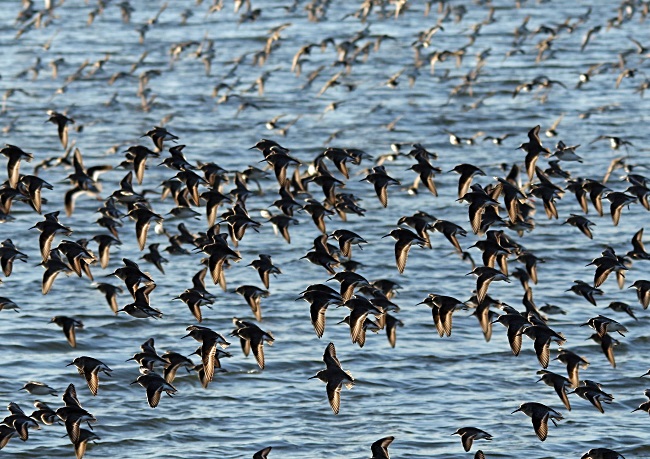
https://elliotsbirdingdiaries.wordpress.com/
There were some good wader roosts at Hoylake during the month, nothing too spectacular except the 1,200 Bar-tailed Godwits on the 13th which is an excellent number for that site. Over 300 have been regularly feeding on Caldy Blacks at low tide, often mixing with the Black-tailed Godwits which reached a maximum of 3,000 - a record for December. There was also a record number of Pintail there with 1,550 on the 13th, with 2,000 off the marsh at Heswall the following day. 20 Scaup were off Leasowe Lighthouse on the 14th.

Up to 500 Pink-footed Geese were feeding in fields close to the Wirral Way at Thurstaston and the largest number recorded on the marshes was 4,000 on Burton Marsh. The Brent Geese having been dispersing away from Hilbre and there were over 200 off Heswall at high tide mid-month and over the Christmas period up to 58 were feeding on Thurstaston Shore close to the Dee SC causeway, seemingly un-bothered by walkers and their dogs close by.
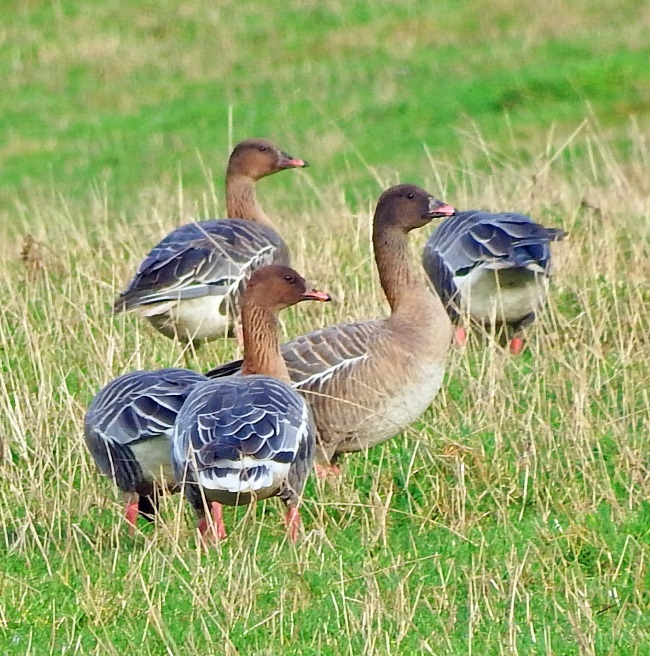
Top of Page
What to expect in January
The big Common Scoter flocks went missing in December but may well return during the month giving some great views in calm weather - along with hundreds of Great Crested Grebes plus Long-tailed Ducks, Goldeneye, Scaup etc. Thousands of Pink-footed Geese on the marshes will make a fantastic sight and it will be interesting to see if the Marsh Harriers stay all winter.
Shotwick Boating Lake is well worth a visit this time of year and in the past we've had Smew and Black-necked Grebes among the more commoner ducks, and a surprisingly large number of Little Grebes.
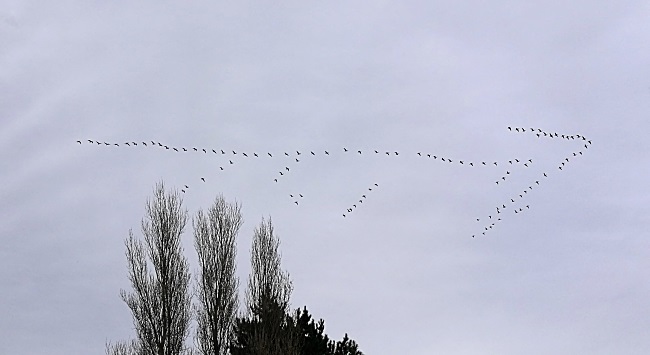
Top of Page
Forthcoming Events
January Highest Spring Tides (Liverpool)
Also
see Tides
page.
13th January, 11.33hrs (GMT), 9.8m.
14th January, 12.18hrs (GMT), 9.8m.
15th January, 13.00hrs (GMT), 9.7m.
Forthcoming Events
Organised by the Wirral
Ranger Service , Flintshire
Countryside Service and the
RSPB (Dee Estuary):
All these events and walks have bird interest, even those not
advertised specifically for birdwatching. No need to book for these
events unless specified - please check below.
Saturday
7th January, 9am to 1pm, Birdwatching Walk to Hilbre.
Join the Wirral Rangers and the RSPB on a guided walk to Hilbre Island
at low tide.
We
will walk to the islands to look for the birds that make Hilbre their
home during the winter months. Hopefully we will connect with Brent
Geese and Purple Sandpipers as well as the usual variety of waders and
wildfowl present on the islands.
Booking essential:
places limited, email deeestuary@rspb.org.uk or
ring 0151 353 8478. £5
per person.
Bring binoculars and wear warm waterproofs.
Saturday 14th
January, 1030am to 1pm, High Tide Birdwatch at Hoylake.
Join
the Coastal Rangers, the Dee Estuary Voluntary Wardens and the RSPB on
this high tide birdwatch at Hoylake to see large numbers of waders as
they gather and roost on the shore.
With a rising tide, we
should see the birds at close quarters as they roost and
feed.
Beginners welcome. Dress warmly and bring binoculars if you
have
them.
There is no need to book. High tide is at 12.08hrs and height 9.8m.
Meet at King’s Gap, King’s Parade, Hoylake.
For further information please telephone Wirral Country Park on (0151)
648 4371.
Sunday 22nd January,
Big Farmland Bird Walk at Burton
Mere Wetlands.
8 am-10 am
Price: Adult £8; RSPB member £6; children half adult prices
Booking essential:
email deeestuary@rspb.org.uk
or ring 0151 353 8478.
Join
us on this exclusive early morning, behind-the-scenes walk to get
closer to the managed farmland parts of the reserve and hopefully find
a range of small birds alongside large flocks of others you might see
on your Big Garden Birdwatch.
Large flocks of small farmland birds
- particularly linnets and reed buntings - feed on our bird cover crop,
along with flocks of gold and greenfinches and other more familiar
garden birds. These in turn attract merlins, sparrowhawks and hen
harriers to hunt.
The nearby wet grassland and barley stubble
offer excellent natural grazing for the geese and swans spending the
winter on the estuary and this walk should provide closer views
particularly of the swan flock on the neighbouring Shotwick Fields.
Please
note this event is weather-dependent. A cold, hard winter will push
more birds to the west coast, so we'll keep our fingers crossed!
Wear
wellies and warm, waterproof clothing, and bring binoculars if you have
them. Price includes a hot drink in the Reception Hide afterwards;
breakfast sandwiches will be available to buy from our on-site catering
van. Advanced booking and payment are essential.
Directions:
RSPB Burton Mere Wetlands, Puddington Lane, Burton, Cheshire, CH64 5SF
Sunday 29th
Januarey,
Raptor Watch at Parkgate.
1pm to dusk.
Join
us for a chance to see up to seven different birds of prey including
peregrine and merlin, plus two types of owl that all make their home on
the RSPB Dee Estuary nature reserve. With its panoramic views of the
saltmarsh, Parkgate is one of the best places to watch for the birds
hunting.
Stick around until dusk for a chance to see the graceful
and endangered hen harriers flying into roost for the night on the
marsh close to the Old Baths car park, plus a ghostly barn owl emerging
to hunt.
No booking required, come along any time between 1 pm and
sunset. Dress appropriately for the weather and don't forget your
binoculars! Public toilets and various pubs and cafes are situated
close by along Parkgate promenade.
Ring 0151 353 8478 for further details.
Directions
The Old Baths car park, Parkgate (just north of The Boathouse pub).
Saturday
4th February, 9am to 1pm, Birdwatching Walk to Hilbre.
Join the Wirral Rangers and the RSPB on a guided walk to Hilbre Island
at low tide.
We
will walk to the islands to look for the birds that make Hilbre their
home during the winter months. Hopefully we will connect with Brent
Geese and Purple Sandpipers as well as the usual variety of waders and
wildfowl present on the islands.
Booking essential:
places limited, email deeestuary@rspb.org.uk or
ring 0151 353 8478. £5
per person.
Bring binoculars and wear warm waterproofs.
Saturday 11th
February, 1000am to 12.30pm, High Tide Birdwatch at Hoylake.
Join
the Coastal Rangers, the Dee Estuary Voluntary Wardens and the RSPB on
this high tide birdwatch at Hoylake to see large numbers of waders as
they gather and roost on the shore.
With a rising tide, we
should see the birds at close quarters as they roost and
feed.
Beginners welcome. Dress warmly and bring binoculars if you
have
them.
There is no need to book. High tide is at 11.21hrs and height 9.6m.
Meet at King’s Gap, King’s Parade, Hoylake.
For further information please telephone Wirral Country Park on (0151)
648 4371.